"Though we have achieved progress, our work is not over. That is why I support the mission of the Arms Control Association. It is, quite simply, the most effective and important organization working in the field today."
Five experts weigh in.
December 2024
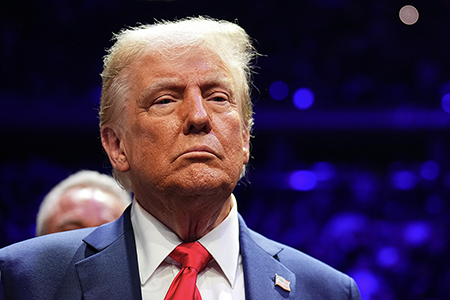
When Donald Trump begins his second term as U.S. president on January 20, he will assume control of an arsenal of 5,044 nuclear weapons and responsibility for guiding U.S. policy toward nine nuclear-armed states, one state that is dangerously close to becoming nuclear-capable and several conflicts that potentially could escalate to nuclear-weapons use. Trump also will assume a major role in deciding the direction of an estimated $1.5 trillion, 30-year program that is already underway to modernize all three legs of the U.S. nuclear triad, including bombers, submarines and missiles. It all occurs as tensions with Russia are at their worst since the Cold War and as Russia and China are pursuing their own nuclear modernization and expansion programs, setting the stage for a new arms race. Arms Control Today invited five experts to examine the challenges with China, Russia, Iran, North Korea and the defense budget faced by Trump, with an eye toward how he could or should manage these problems.—CAROL GIACOMO
- Dangerous Parallax: Chinese-U.S. Nuclear Risks in Trump’s Second Term
By Tong Zhao - Reducing the Russian Nuclear Danger: A Way Forward
By Thomas Countryman - Trump Could Make His Mark With a New Iran Deal
By Ellie Geranmayeh - How Will Trump Balance South and North Korea This Time?
By Jenny Town - Trump, the United States, and the New Nuclear Arms Race
By Geoff Wilson
The new government must find a way to grapple with the conflicting UK policy commitments toward deterrence and disarmament.
December 2024
By Sebastian Brixey-Williams
UK Prime Minister Kier Starmer’s Labour Party has signaled its “unshakeable” and “absolute” commitment to nuclear deterrence after sweeping to power in the United Kingdom in July.
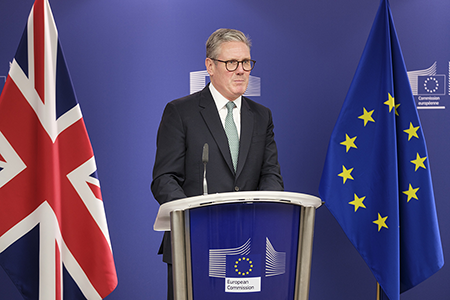
After 14 years of Conservative Party-led government, voters handed Starmer’s party a landslide victory on par with Prime Minister Tony Blair in 1997. Bolstered by an overwhelming majority of members of Parliament, Labour now has the mandate to make ambitious policy change across government. The public will see what that means for nuclear policy when the Strategic Defence Review is released early in 2025.
The review will be headed by Lord George Robertson, reporting to Defence Minister John Healey. Robertson is a Labour defense policy veteran, having served as defense minister in 1997-1999 before becoming NATO secretary-general in 1999-2003. He will work alongside Fiona Hill, a former U.S. National Security Council official, and Richard Barrons, a retired army general and former commander of the UK Joint Forces Command.
The review must articulate Labour’s approach to nuclear weapons policy at a moment of profound international upheaval: the full-scale war against Ukraine waged by Russia; growing violence in the Middle East involving nuclear-armed Israel, which may drive Iran to nuclearize further; ongoing uncertainty about the relationship between China and the West; and growing disquiet about the erosion of the multilateral nonproliferation and disarmament regime. Within this darkening context, how might Labour demonstrate accountable leadership on nuclear weapons policy?
By extending a strong tradition of forward-leaning Labour policy, there are several concrete ways that the new government can demonstrate its commitment to reduce nuclear weapons risks and harms and advance the multilateral disarmament agenda, while signaling Labour’s seriousness about defense and security. To do this, Labour should demonstrate that responsibility, accountability, transparency, and international law are the bedrock principles of the UK nuclear weapons program.
Progressive Opportunities
The review team should start by revisiting the in-depth introspective work done by the civil service on UK nuclear responsibilities with respect to its nuclear weapons, partners, adversaries, and the wider international community. Working through frameworks such as BASIC’s Responsibilities Framework1 has proven a valuable starting point for building shared understanding across government of UK obligations and duties, and much of this prior work still has relevance.
Yet, the review process also should explore whether the UK can reverse the Prime Minister Boris Johnson-era policy of secrecy and return to publicly releasing numbers on the operational stockpile and deployed warheads and missiles. This move would restore confidence in the UK commitment to the principle of transparency, signal its willingness to contribute responsibly to arms control and disarmament dialogue, and remove an excuse for other nuclear-armed states not to behave similarly. It also would signal an important break from the recent UK turn toward rearmament. UK nuclear forces were on a gradual downward trend under successive Conservative governments, with the 2010 strategic review announcing a planned inventory reduction from “not more than 225 to not more than 180” warheads.2 Surprising many observers, the 2021 review increased the cap on warhead numbers from 225 to “no more than” 260. This change was reported widely as a 40 percent increase, based on the 180 figure, even though the actual change may well be narrower.
In another departure from precedent, the 2021 review announced that the government would “no longer give public figures for [the] operational stockpile, deployed warhead or deployed missile numbers,” deepening UK nuclear opacity.3 Yet France, which has a similar-sized nuclear arsenal, does make such information available, and restarting data releases would match the U.S. decision to return to declassifications earlier this year.4 Such a move would strengthen international norms of transparency and accountability and set clear standards for other nuclear-armed states to follow.
Labour also should explore whether the UK can provide greater transparency on nuclear doctrine, with the purpose of making the case to domestic and international audiences about the lawfulness and ethics of its employment policy. There is an incompatibility between the UK “commitment to transparency of doctrine and capability”5 and the policy of being “deliberately ambiguous about precisely when, how, and at what scale” the government would use the weapons.6 This does not mean that Labour needs to start listing target sets publicly, in a manner that could risk national security or be misinterpreted as nuclear threats. Instead, Labour should revive the spirit of elaborating UK nuclear deterrence philosophy as exemplified in a 1980 defense document, which clarified that the state’s nuclear weapons were intended to pose a “potential threat to key aspects of Soviet state power”7 rather than, as its probable author Michael Quinlan later explained, “crude counter-city or counter-population concepts.”8 Nearly half a century later, Labour should reaffirm this principle and explore how to exclude publicly certain varieties of target to signal its compliance with international humanitarian and environmental legal obligations. If this was possible during the Cold War, it should be possible now.
Embracing International Law
Building on this, the UK should commit to updating and expanding its understanding of how international law applies to nuclear weapons targeting. This move has precedent, but the last detailed official document on the subject is the UK’s 1995 statement to the International Court of Justice.9 Customary international law and popular understanding of the effects of nuclear weapons have evolved in significant ways since then. The UK should commit in the new review to articulating in more detail how the principles of distinction, proportionality, and precaution in attack under international humanitarian law would apply to nuclear targeting and the kinds of legal tests that must be met for 100-kiloton UK weapons to be used lawfully. Being transparent about such advice is essential to accountability and especially important when it comes to highly contested legal questions, such as whether belligerent reprisals against civilians populations are lawful.
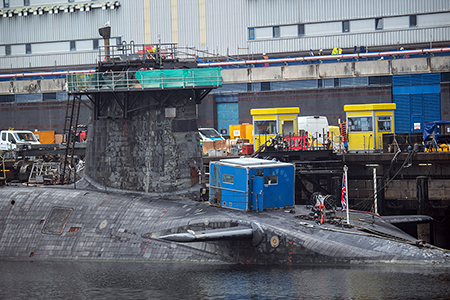
Labour also should elaborate the internal processes by which the Ministry of Defence determines lawfulness, for instance by explaining the role that legal advisers play in screening nuclear targeting plans; the kind of legal advice that prime ministers receive upon entering office while writing their “letter of last resort,” which provides the final orders to Royal Navy ballistic missile submarine commanders in the event that London is believed destroyed; and the way in which legal advice is integrated with nuclear decision-making during crises. Now led by Starmer, a former director of public prosecutions who has campaigned on a platform of integrity and accountability, the government has an opportunity to provide greater confidence that UK nuclear targeting is fully compliant with its legal obligations by clearly articulating its understanding of the law and reaffirming the authority of international law in nuclear targeting more generally.
It is critical too that Labour restore and nourish legislative oversight of nuclear modernization programs, which has diminished dramatically as key members departed Parliament and the public and the media lost interest. The closure this year of the All-Party Parliamentary Group on Global Security and Non-proliferation following dwindling attendance and funding exemplified this trend.10 Labour should replenish the stocks of parliamentarians who consider nuclear weapons policy to be part of their issue brief by grooming and training new members of Parliament and peers of all political parties, with the support of experts countrywide. The government should restart the annual updates to Parliament on the future UK nuclear deterrent, which unexpectedly stopped after 2022.
Labour should launch a comprehensive public inquiry into historic UK nuclear weapons harms to establish whether the UK has caused humanitarian, environmental, or social harms in developing and sustaining its nuclear program and take steps to mitigate or redress these harms where necessary. Harms should be understood broadly, covering the full life cycle of nuclear weapons production, including uranium mining, testing, and the displacement of populations. Those leading the inquiry should engage widely with officials and military officers, lawyers, anthropologists, scientific experts, and affected communities during the investigation. If warranted, the inquiry should produce recommendations for restorative or reparatory justice mechanisms.
Finally, Labour should invest in the UK as an incubator for innovative, practical measures toward multilateral reductions in nuclear weapons. The UK has done detailed work on nuclear disarmament verification and irreversibility in recent years. In addition to building on these foundations, Labour should be more ambitious by reviving and adapting the concept outlined in 2007 by Labour Foreign Secretary Margarett Beckett of positioning the UK as a “disarmament laboratory.”11 Now that the Defence Ministry has established a nuclear deterrence fund, the government should increase spending for new research and diplomatic initiatives on risk reduction, arms control, and disarmament. At this critical juncture, the UK should demonstrate that a world without nuclear weapons is in its vital interests and publicly signal a willingness to be included, under certain conditions, in future multilateral arms control reductions talks.
Labour’s Nuclear Inheritance
These and other recommendations will need to overcome two challenges in UK nuclear politics. First, political attention is directed primarily toward ensuring the viability of UK nuclear deterrence because of the significant programmatic challenges that Labour has inherited and the perception that the country’s adversaries and competitors are placing new strategic demands on it.
The existing Vanguard ballistic missile submarine program is in poor shape. Submarine sea patrols, previously no more than three months, are being forced to remain at sea for as many as six months due to spiraling repairs and reported challenges in recruiting crew.12 In 2022, one of the four UK submarines finally returned to service from a refit that was extended from four years to seven after the scope was expanded beyond the original plans and failures in workforce and infrastructure investments. During the extra three years that the HMS Vanguard was in dry dock, the Royal Navy was forced to try to maintain its mission of keeping at least one submarine at sea at all times while at times missing 25 to 50 percent of its operational submarine fleet. Major questions remain on whether the submarine replacement program Dreadnought will meet its deadline for having the first boat enter service in the early 2030s.13 Labour must be careful about its messaging to avoid being blamed for operational, budgetary, or procurement failures that preceded its mandate.
Labour also inherits a nuclear warhead modernization program at a critical juncture, the Astraea. Although promoted as a “sovereign design,” this warhead is being “delivered in parallel with” the U.S. W93 warhead.14 The name of the UK warhead was carefully calibrated: Astraea is named after the Roman goddess of justice and, according to some sources, innocence, purity, and precision. In some depictions, she fittingly carries a thunderbolt of justice and was said by the epic poet Hesiod to have been the last deity to leave the earth during the evil days of the Bronze Age, when warlike men were consumed by their own rage and perished.15 The most recent program update to Parliament in 2022 stated that the warhead had moved into the concept phase, but little more is known about the program. David Cullen, executive director of the watchdog Nuclear Information Service, has reasoned that the “technological dependency of the UK nuclear weapons program on the United States means that the UK Replacement Warhead is likely to have a similar design to the W93, and may therefore produce a significantly higher yield than the current UK warhead.”16 If true, this raises important questions as to whether the UK modernization plans are geared more toward like-for-like replacement or a capability change.
Starmer’s government also may have inherited a country poised for U.S. forward deployments. Although not mentioned in the 2021 review, the Federation of the American Scientists, citing a vague U.S. budget reference, reported in 2023 the possibility that RAF Lakenheath is being readied again as a base for U.S. nuclear weapons.17 London has declined to comment on this report, but there are plausible reasons why it might be true. With U.S. attention increasingly focused on China, the UK appears to be taking on a greater share of the responsibility for NATO’s nuclear deterrence against Russia. This will be especially true under the second Trump administration, whose attention will be on China and will call for European allies to take greater responsibility for their own defense.
London also may be concerned about its lack of substrategic options compared to Russia. Although it is commonly assumed that the UK still has the capacity to deploy a low-yield variant of its Holbrook warhead, it is difficult to imagine that more than one or two missiles per boat would be dedicated to this variant or that they would be used readily because their use simultaneously would locate the UK’s second-strike capability. U.S. forward deployments might provide a cost-efficient alternative to developing a U.S. low-yield nuclear capability, for instance by reestablishing a Royal Air Force nuclear capability or arming Royal Navy attack submarines with nuclear-tipped cruise missiles. Such basing also would put another bargaining chip on the table for any longer-term European arms control and demilitarization. In essence, NATO could attempt to trade U.S. weapons at Lakenheath for Russian weapons in Belarus without fundamentally changing the remaining balance of nuclear, missile defense, or other forces in Europe.
The increase to the UK warhead cap, London’s rollback in transparency measures, and the credible possibility of U.S. forward deployments have ended an extended period of complacency about the irreversibility of UK disarmament progress and demonstrated that the civil service is not locked into a linear course toward nuclear elimination. Although the new leaders undertaking the Strategic Defence Review are well-informed, the process will be advised by an entrenched cadre of civil servants, which will surely influence Labour’s nuclear weapons policy. The strategic context in Europe has changed dramatically since the 2022 full-scale Russian invasion of Ukraine, meaning further increases to the UK warhead cap or even the adoption of new capabilities should not come as a surprise.
Starmer’s Opening Position
The second key challenge is that the diminished space for democratic debate on UK nuclear politics is now led from the top of the Labour Party itself. Starmer came out swinging in his election campaign to dispel any allegation that the party is “weak on defence,” a deep-rooted association that has been an Achilles heel in Labour’s domestic policy platform for decades. Indeed, Starmer’s “unshakeable” and “absolute” commitment to nuclear deterrence is stauncher than any recent Labour leader. Contrast this to the equivocal, almost flippant position taken by former Prime Minister Blair in his memoir on the Trident renewal decision in 2006: “[A]fter some genuine consideration and reconsideration, I opted to renew.… I said to [Gordon Brown]: imagine standing up in the House of Commons and saying I’ve decided to scrap it. We’re not going to say that, are we?”18
At the top of Starmer’s mind will be closing off any comparison with his predecessor, Jeremy Corbyn, who ran on a divisive platform advocating pacifism and unilateral nuclear disarmament and later was mired in anti-Semitism allegations. Corbyn’s public refusal to “push the button,” however noble in its intention, undoubtedly harmed Labour’s electability.19 Formerly in Corbyn’s shadow cabinet, Starmer is doing everything he can to sever any association with his predecessor and depoliticize nuclear weapons for his government so it can focus on the country’s myriad domestic challenges.

Eliminating any doubt about Starmer’s commitment to a “triple lock” on the nuclear deterrent,20 the government’s first major public act has been the extension of the UK-U.S. Mutual Defence Agreement. This included the permanent removal of the need to renew the key clause on the transfer of materials and equipment every 10 years,21 further embedding cooperation and eliminating a substantial risk to the continuity of the UK nuclear program. Although the allies still may review minor technical updates to the agreement, this major indefinite extension decision will deprive elected officials in both countries of the opportunity to revisit the more fundamental principle of whether to share nuclear materials and equipment in future years.
Indeed, Starmer is under little political pressure to concede ground on disarmament. The near-total electoral collapse of the Scottish National Party, having nosedived from 49 to 9 seats in Scotland’s 57 constituencies, looks to have weakened permanently efforts toward a second Scottish independence referendum and unilateral nuclear disarmament in the UK. Only a few years ago, Scottish independence appeared to be the most likely route to a unilaterally disarmed UK, given the immense practical, legal, and financial difficulties of relocating the nuclear submarine base to one of the few deepwater ports elsewhere in the country.22 Not so today.
Although Starmer’s opening statements have been forthrightly pro-nuclear, Labour ultimately may soften its approach. Evidence of this can be seen in the foreign policy philosophy set out by Foreign Secretary David Lammy, who has campaigned as a “progressive realist” with hopes to weave together elements of an “ethical foreign policy” espoused by the late Foreign Secretary Robin Cook with “tough on defence” pragmatism.23 The message is one of continuity with a difference: an approach to defense and security that is framed as strong and serious, but differentiated from its predecessors through its greater moral sensibility. The government is not short of international security or foreign policy decisions by which Lammy’s vision can be tested.
As the strategic review gets underway, Starmer’s government must find its own way to grapple with the conflicting UK policy commitments toward deterrence and disarmament. Domestic political pressures, limited parliamentary capacity, and an unstable international environment make reductions to the UK arsenal improbable; they may even reverse further. Yet, nearly two decades on, Beckett’s words are as true today as they were in 2007; and Labour would do well to recall them: “The judgement we made forty years ago, that the eventual abolition of nuclear weapons was in all of our interests - is just as true today as it was then. For more than sixty years, good management and good fortune have meant that nuclear arsenals have not been used. But we cannot rely on history just to repeat itself.”24
ENDNOTES
1. Sebastian Brixey-Williams, Alice Spilman, and Nicholas J. Wheeler, “The Nuclear Responsibilities Toolkit: A Practical Guide for Thinking, Talking and Writing,” British American Security Information Council (BASIC) and Institute for Conflict, Cooperation and Security, September 2021, p. 25, https://basicint.org/wp-content/uploads/2022/01/BASIC_Nuclear-Responsibilities-Toolkit_2nd-Edition.pdf.
2. “Securing Britain in an Age of Uncertainty: The Strategic Defence and Security Review,”
Cm 7948, October 2010, p. 39.
3. The Campaign for Nuclear Disarmament commissioned a legal advice that sought to challenge the lawfulness of the buildup, which concluded that the “announcement by the UK government of the increase in nuclear warheads and its modernisation of its weapons system constitutes a breach of the [nuclear Nonproliferation Treaty Article] VI,” but puzzlingly it stopped short of litigating the decision in the courts. Christine Chinkin and Louise Arimatsu, “ Legality Under International Law of the United Kingdom’s Nuclear Policy as Set Out in the 2021 Integrated Review,” Campaign for Nuclear Disarmament (CND), April 2021, https://cnduk.org/wp-content/uploads/2021/05/CND-legal-opinion-1.pdf.
4. U.S. National Nuclear Security Administration, “Transparency in the U.S. Nuclear Weapons Stockpile,” n.d., https://www.state.gov/wp-content/uploads/2024/07/U.S.-Nuclear-Weapons-Stockpile-Transparency-2024_2.pdf (data as of September 2023).
5. 2020 Review Conference of the Parties to the Treaty on the Non-Proliferation of Nuclear Weapons, “National Report of the United Kingdom of Great Britain and Northern Ireland Pursuant to Actions 5, 20 and 21 of the Action Plan of the 2010 Review Conference of the Parties to the Treaty on the Non-Proliferation of Nuclear Weapons for the Tenth Review Conference of the Parties to the Treaty,” NPT/CONF.2020/33, November 5, 2021, p. 33.
6. UK Defence Nuclear Organisation, “The UK’s Nuclear Deterrent: What You Need to Know,” n.d., https://www.gov.uk/government/publications/uk-nuclear-deterrence-factsheet/uk-nuclear-deterrence-what-you-need-to-know (accessed November 17, 2024).
7. UK Ministry of Defence, “The Future United Kingdom Strategic Nuclear Deterrent Force,” Doc. 80/23, July 1980, para. 12, https://nsarchive.gwu.edu/sites/default/files/documents/qw8t8k-z13mv/34.pdf.
8. Michael Quinlan, Thinking About Nuclear Weapons: Principles, Problems, Prospects (Oxford: Oxford University Press, 2009), p. 126.
9. UK Foreign and Commonwealth Office, “Legality of the Threat or Use of Nuclear Weapons (Request for an Advisory Opinion by the United Nations General Assembly): Statement of the Government of the United Kingdom,” June 1995, https://www.icj-cij.org/sites/default/files/case-related/95/8802.pdf.
10. Sebastian Brixey-Williams, “APPG on Global Security and Non-Proliferation to Close After 24 Years,” May 14, 2024, https://basicint.org/appg-to-close-after-24-years/.
11. “Keynote Address: A World Free of Nuclear Weapons?” Carnegie Endowment for International Peace, June 25, 2007, https://carnegieendowment.org/events/2007/06/keynote-address-a-world-free-of-nuclear-weapons (remarks of Margaret Beckett) (hereinafter Beckett address).
12. CND, “Royal Navy Struggles to Attract Recruits for Nuclear-Armed Subs,” June 19, 2023, https://cnduk.org/royal-navy-struggles-to-attract-recruits-for-nuclear-armed-subs/.
13. Toby Fenwick, “(Dis)Continuous Deterrence: Challenges to Britain’s Nuclear Doctrine,” BASIC, September 2018, https://basicint.org/wp-content/uploads/2018/11/DisContinuous-Deterrence-Web.pdf.
14. UK Defence Nuclear Enterprise, “Delivering the UK’s Nuclear Deterrent as a National Endeavour,” CP 1058, March 2024.
15. “Astraea,” Oxford Reference, n.d., https://www.oxfordreference.com/display/10.1093/oi/authority.20110803095430649 (accessed November 17, 2024).
16. David Cullen, “Extreme Circumstances: The UK’s New Nuclear Warhead in Context,” Nuclear Information Service, August 2022, p. 49, https://www.nuclearinfo.org/wp-content/uploads/2022/08/Extreme-Circumstances-print-version.pdf.
17. Matt Korda and Hans Kristensen, “Increasing Evidence That the US Air Force’s Nuclear Mission May Be Returning to UK Soil,” Federation of American Scientists, August 28, 2023, https://fas.org/publication/increasing-evidence-that-the-us-air-forces-nuclear-mission-may-be-returning-to-uk-soil/.
18. “Blair on Trident: ‘There Was a Case Either Way,”’ Nuclear Information Service, March 9, 2010, https://www.nuclearinfo.org/blog/nuclear-information-service/2010/09/blair-trident-there-was-case-either-way/.
19. Patrick Wintour, “Jeremy Corbyn: I Would Never Use Nuclear Weapons If I Were PM,” The Guardian, September 30, 2015, https://www.theguardian.com/politics/2015/sep/30/corbyn-i-would-never-use-nuclear-weapons-if-i-was-pm.
20. Nick Ritchie, “Keir Starmer’s Trident Triple Lock: How Britain’s Obsession With Nuclear Weapons Has Become Part of Election Campaigns,” The Conversation, June 6, 2024, http://theconversation.com/keir-starmers-trident-triple-lock-how-britains-obsession-with-nuclear-weapons-has-become-part-of-election-campaigns-231834.
21. UK Secretary of State for Foreign, Commonwealth and Development Affairs, “Amendment to the Agreement Between the Government of the United Kingdom of Great Britain and Northern Ireland and the Government of the United States of America for Cooperation on the Uses of Atomic Energy for Mutual Defense Purposes,” CP 1135, July 2024.
22. Sebastian Brixey-Williams, “Voting for Trident Before the Scotland Question Is Settled Is Illogical,” BASIC, July 18, 2016, https://basicint.org/news/2016/voting-trident-scotland-question-settled-illogical.
23. “A Friend of Obama Who Could Soon Share the World Stage With Trump,” The New York Times, April 21, 2024.
Sebastian Brixey-Williams is executive director of BASIC, a think tank, and a research fellow at the Harvard Kennedy School Project on Managing the Atom.
A working group charged with recommending ways to improve the BWC has made some substantial progress but there is complex work still ahead.
December 2024
By Jez Littlewood and Filippa Lentzos
By the end of this month, states-parties will be halfway through their latest attempt to strengthen the Biological Weapons Convention (BWC). This effort was launched in 2022 at the convention’s ninth review conference with the establishment of a working group to “identify, examine and develop specific and effective measures, including possible legally binding measures, and to make recommendations to strengthen and institutionalize the Convention in all its aspects.”1
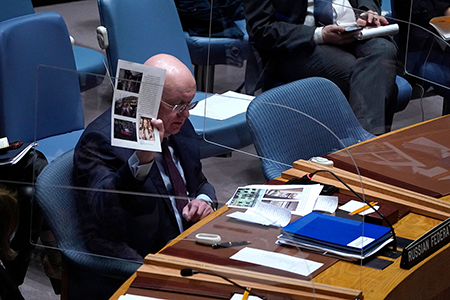
The working group was tasked with addressing seven areas: international cooperation and assistance, scientific and technological developments relevant to the convention, confidence building and transparency, compliance and verification, national implementation, assistance, response and preparedness in the event of use of biological or toxin weapons, and organizational, institutional, and financial issues. States-parties also decided to develop two mechanisms to support the BWC: one to review and assess scientific and technological developments and provide advice to states-parties on their implications and the other to facilitate and support international cooperation and assistance under BWC Article X, which covers peaceful uses of biology. Both mechanisms would be developed by the working group, which would make recommendations to states-parties.
The working group was given 60 days (15 days a year over four years) to make recommendations to strengthen and institutionalize all aspects of the BWC. How to best accomplish this has been contentious throughout the treaty’s nearly 50-year history. Most of the topics have been explored previously, with states-parties failing to reach consensus on advancing more robust transparency, cooperation, and compliance procedures. Now it is being done again in a period of particularly fraught geopolitical relations.
Substantial progress has been made in some areas, but beneath the surface is a broader conflict about the shape of arms control agreements generally. This raises a question about whether strengthening the BWC needs to follow the traditional model of legally binding multilateral agreements with declarations, inspections, investigations, and an international organization where consensus rules or whether states-parties can agree to a new model that allows states to opt in to the mechanisms with which they agree and opt out of any processes or new commitments they are unable to support.
The Working Group
Perhaps the most interesting aspect of the working group agenda was the inclusion of verification and compliance issues as topics for discussion. Their inclusion raised the possibility of legally binding measures similiar to the protocol on verification provisions from the 1990s.
Since 2001, when negotiations on a verification protocol collapsed, multiple events have influenced how states and civil society think about the BWC, its weaknesses, and ways to strengthen it. These include the 9/11 terrorist attacks, the anthrax letters targeting media outlets and politicians shortly after those attacks, the Iraq war, and the Organisation for the Prohibition of Chemical Weapons (OPCW) response to Syria’s use of chemical weapons. In addition, there have been fears of terrorist groups acquiring biological weapons, significant scientific and technological developments that have lowered the barriers to biological weapons development for nefarious actors, the COVID-19 pandemic, Russia’s rejected allegations of offensive biological weapons activity by the United States and Ukraine, and changing attitudes toward arms control and disarmament.
The first session of the working group, in March 2023, organized the group’s 60 days of work on a schedule that would include 10 days focused on compliance and verification; eight days each on international cooperation and assistance and scientific and technological developments; seven days on assistance, response, and preparedness; five days each on confidence building and transparency and national implementation; four days on organizational, institutional, and financial issues; two days on each of the mechanisms; four days to consider issues related to all topics; and five days to complete any leftover work and write the report. To date, more time has been spent on cooperation issues and scientific and technological development compared to compliance and verification and other areas. As a result, compliance and verification issues are more conceptual but a new working paper by the United States and six other states-parties is more concrete than anything else put forward for over two decades.2
At this stage, three visions of how to strengthen the BWC are emerging. The first is a traditional arms control approach centered on a multilaterally negotiated, legally binding verification treaty, essentially a return to the protocol debated in the 1990s. The second is a pragmatic approach that embraces the working group’s task to explore and make recommendations that fulfill the objective of strengthening the effectiveness and improving the implementation of the BWC. The pragmatists are not prejudging how to achieve that objective. It may involve a range of approaches and could include a legally binding component. The third approach is incremental and suggests a way forward that is built on a series of actions and activities completed by states-parties in different ways that cumulatively move BWC implementation forward through national, bilateral, and multilateral approaches. Although multilateralism is one component of action, states can pursue other approaches outside the convention.
The Traditional Approach
For a few states-parties, the weaknesses of the BWC are mainly if not completely the result of the U.S. decision in July 2001 to reject the draft version of the verification protocol. China, Iran, and Russia are the dominant voices advocating for a traditional approach to strengthening the BWC, as they have been for most of the last 20 years.
Each state has a slightly different emphasis, based on their formal proposals reflected in working papers. For Iran, the dominant issue is peaceful cooperation and technology transfer, and its main target is sanctions; anything other than a legally binding agreement is insufficient. China’s starting point is to review the work on the protocol completed in the 1990s to assess its applicability to any future negotiations.
Of the three, Russia seems most determined to live in the past, having resurrected its previous proposals for agreed definitions and terminology, lists of pathogens and equipment that are relevant to offensive biological weapons activity, and quantitative and material accountancy approaches to determine compliance.3 Quantitative approaches to determining compliance with Article I of the BWC are anathema to most Western states-parties because the convention prohibition hinges not on specific things or identified amounts, but on the purpose for which something is being used. Material accountancy approaches will not work in the BWC.
Although it would be incorrect to characterize everything espoused by China, Iran, and Russia as unhelpful, each has a vision of a strengthened convention that places consensually agreed-on procedures, mechanisms, and approaches as the only way to determine confidence in compliance. Mechanisms outside the convention are irrelevant to their vision of a strengthened BWC: only states and what states want are relevant.
The Pragmatic Approach
The pragmatic approach is apparent in the wide variety of states-parties that are focused on the task of the working group and using its meetings to find ways to strengthen the convention. A legally binding approach is favored by many but not all of these states, and it is not an option that excludes other approaches, at least so far. By identifying ways to improve and enhance implementation of the BWC but not prejudging or committing to how that might be achieved, this approach is allowing ideas to get a fair hearing and have an opportunity to ripen. Importantly, this approach allows for verification to be discussed by states-parties. Because verification has not been covered by the BWC for more than 20 years, the distinctions between verification as an abstract concept and verification as a real, complex challenge is something that requires time and discussion to emerge.
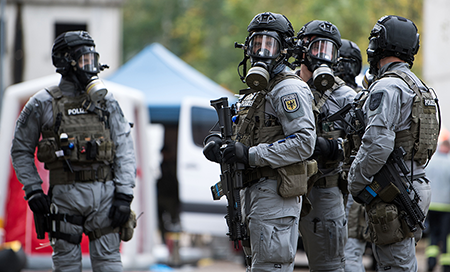
A notable aspect of the pragmatic approach is the groups of states that have come together to advance proposals that cut across the old regional and nonaligned blocs that bedevilled consensus agreement in the past. Denmark, Malawi, Montenegro, Norway, Panama, Singapore, and Uruguay presented a joint paper identifying key considerations in any discussion of verification.4 Georgia, Malawi, Norway, and the Philippines identified five elements that generated broad convergence for a mechanism for international cooperation and assistance.5 Kenya and Panama proposed to strengthen and institutionalize the BWC by enhancing youth engagement, building on the Youth Declaration for Biosecurity.6
Meanwhile, France and India, building on their earlier cooperation from 2018 on a database for assistance under the framework of Article VII, proposed cooperating with the Implementation Support Unit (ISU) on a modular, phased approach to the actual establishment of the database as a working group recommendation.7 The Association of Southeast Asian Nations brought attention to regional cooperation under its chemical, biological, and radiological defense experts group and with other international organizations and bodies such as the UN 1540 Committee.
Emphasizing cooperation with other international actors is a second aspect of the pragmatic approach. In papers presented to the working group by states that cut across traditional interest blocs, scores of entities, including the World Health Organization, the Food and Agriculture Organization, the World Organisation for Animal Health, the European Union, and the Global Partnership Against the Spread of Weapons and Materials of Mass Destruction, have been identified as relevant to the future strengthening of the BWC.
The Incremental Approach
The incremental approach can be discerned not by what it stands for but what it is opposed to: a single, legally binding instrument as the only way to strengthen the convention. States in this camp tend to focus on existing approaches that can be improved rather than new initiatives. They tend to identify what exists in the BWC or outside of it that is relevant as examples for moving forward. Predominantly, they include the United Kingdom, the United States, and the EU, but as with the pragmatic group, there is no single vision on which they all agree.
Opposition to the single, legally binding instrument does not mean rejection of any legally binding mechanisms. The EU and its member states said they could envisage national declarations consistent with existing BWC confidence-building measures.8 This was similar to the U.S. proposal for the working group to consider measures to achieve consistent implementation of the confidence-building measures and how to transform any of them into annual, legally binding declaration requirements.9
Similarly, the United States and the EU noted the need for an investigation process and the possibility of other special measures to address serious suspicions of violations. For the EU, this would be a challenge or special inspection component with strong links to the UN secretary-general mechanism. The United States also identified a certified network of laboratories, possibly in partnership with the OPCW given the toxins overlap, as an option for consideration.
Another aspect of the incremental approach is a focus on strengthening national implementation and enhancing the institutional mechanisms of the BWC. For the UK, compliance depends on effective implementation at the national level and other domestic measures.10 Many of these approaches are evident in the new paper outlining the possible functions of a new BWC implementation organization submitted by the United States and six co-sponsors, including on-site familiarization visits to maximum containment laboratories, technical assistance, more effective national implementation, and enhanced international cooperation as ways to institutionalize implementation.
International cooperation plays an important role in the vision of the future convention for these states, but it should be realistic and focus on what works in the real world rather than traditional concepts of what multilateral verification looked like in the 1990s.11 In this category, ongoing practices such as the Global Partnership, which has launched more than 311 projects valued at more than $1.6 billion and funded by more than 20 states since 2016, can be the basis of improvement.12
Mechanisms as a Foundation
Although ongoing discussions in many areas are overly conceptual, the mechanisms are developing at a quick pace. Friends of the chair groups aligned, respectively, with the international cooperation and assistance and the science and technology mechanisms issued nonpapers to stimulate additional thinking during July and August. One idea with wide support is that the mechanisms could be a foundation and catalyst for additional action going forward. If agreed, they could set a cadence of future annual meetings and activity that would be focused and directly relevant to strengthening the BWC.
In the nonpapers, the mechanisms are structured as being open to all states-parties while a smaller group of representative states-parties would conduct more focused work. The proposed international cooperation and assistance program would be overseen by a steering group and supported by a newly created assistance fund. The steering group is expected to have up to 21 state-party members who reflect a broad geographic distribution and gender balance. In contrast, the proposed science and technology advisory board would work with an advisory group, which is open to all states-parties; a subcommittee of up to 30 members; and temporary working groups to focus on areas where specific technical expertise is required.
The nonpapers call for six additional staff in the ISU to support work with each mechanism and for additional meeting time for their respective areas. The additional costs will be met by increasing the assessed contributions of states-parties. Building on working papers from a variety of states, the international cooperation and assistance mechanism would fund projects based on requests that outlined the objectives, intended outcomes, proposed timelines, and the resources required to implement and sustain the projects.13 There also would be a co-pay element, with most of the states that request assistance providing 15 percent of the costs. Projects would be supported by a voluntary trust fund.
For the science and technology mechanism, the focus is not solely on the risks posed by scientific and technological developments, but also on the opportunities they present to strengthen BWC implementation. As such, there is a complementary and potentially synergistic aspect to the mechanisms. It is possible to envisage a promising science or technology development that has the potential to strengthen implementation of the BWC being identified and assessed by the science and technology mechanism and then funded as a pilot project under the international cooperation mechanism. Assuming some level of success that is identifiable, scaling up the adoption of that innovation becomes an option that any interested state-party might pursue, perhaps with additional funding from other organizations. Much is still to be decided in both mechanisms, but each is sufficiently well developed that the working group potentially could deliver early in 2025 on at least one of its core objectives: recommendations on the establishment of two new BWC mechanisms.
Challenges Ahead
The task before the working group is complex, and it will be easier to fail than succeed. The challenges include some issues of substance, many issues where flexibility will be required, and the securing of a commitment by all who want to strengthen the convention to spend more time and significantly more money to achieve their stated objectives.
One issue of substance is the legally binding approach. If the failed 2001 protocol or some new variant of it as a single, legally binding instrument is the only acceptable way forward for a few states-parties or if any legally binding measure is unacceptable to a few other states-parties, this impasse likely will doom any chance of a consensus report on recommendations.
Flexibility will be required in how the mechanisms are finalized. The international cooperation mechanism is more focused and pragmatic than the traditional open-ended, unspecific calls for more money, more cooperation, and more technology transfers.
A third challenge is money. Some states-parties claim they cannot support any rise in their assessed contributions to offset large BWC budget increases. If that is the case, work may as well end now. There is no feasible way to strengthen the convention without a commitment to more meetings, more institutional support, and more staff for the Implementation Support Unit. A parsimonious approach will not alleviate the BWC weaknesses.
Overall, the working group has made progress, thanks in part to the states-parties that are gravitating to what might be pragmatic and incremental possible solutions rather than what would be ideal. Even if pragmatism and incrementalism wins and the working group succeeds at making recommendations on two mechanisms and on ways to strengthen the convention in seven areas, decisions still will have to be made in 2027 at the 10th BWC review conference. As such, even if the working group succeeds, there remains significant work to be done beyond that point.
ENDNOTES
1. Ninth Review Conference of the States Parties to the Convention on the Prohibition of the Development, Production and Stockpiling of Bacteriological (Biological) and Toxin Weapons and on Their Destruction, “Final Document of the Ninth Review Conference,” BWC/CONF.IX/9, December 22, 2022.
2. Working Group on the Strengthening of the Convention on the Prohibition of the Development, Production, and Stockpiling of Bacteriological (Biological) and Toxin Weapons on Their Destruction,“Possible Structure/Functions of a BWC Implementation Organization: Submitted by the United States of America, Co-sponsored by Australia, Bulgaria, Germany, Slovenia, Sweden, and the United Kingdom of Great Britain and Northern Ireland,” BWC/WG/5/WP.1, November 12, 2024.
3. Working Group on the Strengthening of the Convention on the Prohibition of the Development, Production and Stockpiling of Bacteriological (Biological) and Toxin Weapons and on Their Destruction, “Contemporary Challenges to the Objectives of the Convention on the Prohibition of the Development, Production and Stockpiling of Bacteriological (Biological) and Toxin Weapons and on Their Destruction (BTWC) Related to the Development of Synthetic Biology Technologies and Practical Approaches to Overcome Them: Submitted by Russia,” BWC/WG/2/WP.15, August 7, 2023.
4. Working Group on the Strengthening of the Convention on the Prohibition of the Development, Production and Stockpiling of Bacteriological (Biological) and Toxin Weapons and on Their Destruction, “Key Considerations When Relaunching the Discussion on Verification and Compliance in the Context of the Biological Weapons Convention: Submitted by Denmark, Kenya, Malawi, Montenegro, Norway, Panama, Singapore, Thailand and Uruguay,” BWC/WG/3/WP.8/Rev.1, December 7, 2023.
5. Working Group on the Strengthening of the Convention on the Prohibition of the Development, Production and Stockpiling of Bacteriological (Biological) and Toxin Weapons and on Their Destruction, “Considerations Regarding an International Cooperation and Assistance (ICA) Action Plan: Submitted by Georgia, Malawi, Norway and the Philippines,” BWC/WG/2/WP.22, August 10, 2023.
6. Working Group on the Strengthening of the Convention on the Prohibition of the Development, Production and Stockpiling of Bacteriological (Biological) and Toxin Weapons and on Their Destruction, “Engaging the Next Generation Leaders in Global Biosecurity: Proposals for Strengthening Youth Participation in the Biological Weapons Convention; Submitted by Kenya and Panama,” BWC/WG/2/WP.24, August 18, 2023.
7. Working Group on the Strengthening of the Convention on the Prohibition of the Development, Production and Stockpiling of Bacteriological (Biological) and Toxin Weapons and on Their Destruction, “Proposal for the Establishment of a Database for Assistance Under Article VII of the Biological and Toxin Weapons Convention: Submitted by France and India,” BWC/WG/4/WP.4, August 13, 2024.
8. Working Group on the Strengthening of the Convention on the Prohibition of the Development, Production and Stockpiling of Bacteriological (Biological) and Toxin Weapons and on Their Destruction, “Position of the European Union on Compliance With and Verification Under the Biological and Toxin Weapons Convention: Submitted by the European Union,” BWC/WG/3/WP.17, December 8, 2023.
9. Working Group on the Strengthening of the Convention on the Prohibition of the Development, Production and Stockpiling of Bacteriological (Biological) and Toxin Weapons and on Their Destruction, “U.S. Approach to the Working Group on the Strengthening of the Biological Weapons Convention: Submitted by the United States of America,” BWC/WG/3/WP.9/Rev.1, January 4, 2024.
10. Working Group on the Strengthening of the Convention on the Prohibition of the Development, Production and Stockpiling of Bacteriological (Biological) and Toxin Weapons and on Their Destruction, “Building Global Biosecurity via Confidence in Compliance With the Biological and Toxin Weapons Convention: Submitted by the United Kingdom,” BWC/WG/3/WP.6, November 20, 2023.
11. Working Group on the Strengthening of the Convention on the Prohibition of the Development, Production and Stockpiling of Bacteriological (Biological) and Toxin Weapons and on Their Destruction, “Assistance and Cooperation Under Article X - Background and Options for Consideration: Submitted by the United Kingdom,” BWC/WG/2/WP.2, July 21, 2023.
12. Ninth Review Conference of the States Parties to the Convention on the Prohibition of the Development, Production and Stockpiling of Bacteriological (Biological) and Toxin Weapons and on Their Destruction, “International Activities of Global Partnership Member Countries Related to Article X of the Biological and Toxin Weapons Convention (2017-2022),” BWC/CONF.IX/WP.51, December 6, 2022.
13. Working Group on the Strengthening of the Convention on the Prohibition of the Development, Production and Stockpiling of Bacteriological (Biological) and Toxin Weapons and on Their Destruction, “Proposal for Cooperation and Assistance Mechanism Under Article X: Submitted by Pakistan,” BWC/WG/2/WP.13, August 4, 2023; Working Group on the Strengthening of the Convention on the Prohibition of the Development, Production and Stockpiling of Bacteriological (Biological) and Toxin Weapons and on Their Destruction, “Assistance and Cooperation under Article X - Background and Options for Consideration: Submitted by the United Kingdom,” BWC/WG/2/WP.2, July 21, 2023; Working Group on the Strengthening of the Convention on the Prohibition of the Development, Production and Stockpiling of Bacteriological (Biological) and Toxin Weapons and on Their Destruction, “Considerations Regarding an International Cooperation and Assistance (ICA) Action Plan: Submitted by Georgia, Malawi, Norway and the Philippines,” BWC/WG/2/WP.22, August 10, 2023.
Jez Littlewood, a policy analyst, previously served on the faculty at Carleton University in Canada and on the Secretariat of the Biological Weapons Convention (BWC) ad hoc group at the United Nations in Geneva. Filippa Lentzos is an associate professor at King’s College London, a member of the UK Biosecurity Leadership Council, and the BWC nongovernmental organizations coordinator. This article is supported by research funding under the Key Verification Assets Fund of the U.S. Department of State Bureau of Arms Control, Deterrence, and Stability.
December 2024
By Geoff Wilson
The world is on the brink of a frightening new nuclear age. Over the past decade, all nine of the world’s nuclear-armed states have committed to a path of expansive new nuclear weapons spending and modernization. Many of these nuclear programs have grown to include not only upgrading and retrofitting extant nuclear weapons systems, but also the development of entirely new weapons including many described as “exotic,” “battlefield,” or “nonstrategic.” Many experts say this trend is a worrisome departure from traditional “deterrence-based” approaches and may herald a return to a more coercive Cold War-like role for the world’s nuclear arsenals.
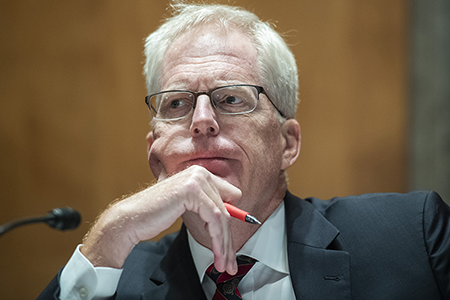
The United States has led the charge in this new nuclear arms race, dedicating $1.7 trillion to its nuclear arsenal over the next 30 years, or roughly $75 billion a year between fiscal years 2023 and 2032, according to the nonpartisan Congressional Budget Office. To put that figure into context, adjusted for inflation to 2023 dollars, the four years of the Manhattan Project cost approximately $30 billion, while all eight years of President Ronald Reagan’s nuclear buildup cost about $75 billion.1 That means that Washington currently is spending twice as much a year on nuclear weapons as it did during all four years of the nuclear weapons development during World War II and the same amount as during all eight years of the last major nuclear spending drive of the Cold War.
This spending spree is underwriting a transformational effort to replace simultaneously all three legs of the U.S. nuclear triad—the land-based missiles, strategic bombers, and stealthy nuclear submarines that carry most of the 1,670 U.S. deployed strategic nuclear warheads. It has opened the door to development of the first entirely new nuclear warheads and plutonium weapons cores that the United States has built since the 1980s and ultimately may force the state to consider resuming nuclear testing for the first time since 1992. Unfortunately for U.S. taxpayers, most of these expensive programs are significantly behind schedule and overbudget.2
Donald Trump’s election to a second presidential term is likely to stoke this new nuclear arms race even further. During his first term, President Trump’s agenda was a paradigm shift from how nearly all his predecessors acted in regard to the U.S. nuclear arsenal. The way Trump talked about nuclear weapons, supposedly asking at one point “if we have these weapons, why can’t I use them” and threatening North Korea with “fire and fury like the world has ever seen,” shocked many people.3 The development of new and more usable nonstrategic nuclear weapons such as the W76-2 warhead, which is deployed on Navy submarines, and the nuclear-armed submarine-launched cruise missile, which is still under development, signaled that the United States might turn away from Reagan’s declaration that “a nuclear war cannot be won and must never be fought” and instead could see a use for a “limited” nuclear strike and war-fighting strategy.
As a result, there is real cause for concern that the United States will continue to commit itself to an expanded role for nuclear weapons in its military and foreign policy. Congressional leaders, military commanders, and former Trump administration officials are campaigning for new nuclear weapons and funding above the current $1.7 trillion nuclear modernization program. Nuclear spending boosters point to the recent findings of the Congressional Commission on the Strategic Posture of the United States, which among other escalatory steps suggested that the government consider developing new road-mobile intercontinental ballistic missiles (ICBMs) and new tactical nuclear forces to be deployed in the Indo-Pacific and European theaters.4
Senator Deb Fischer (R-Neb.), for one, argued that the report showed that the massive $1.7 trillion program of record was “essential, although not sufficient” to maintain U.S. national security in the near future.5 Pointedly, when questioned at a Senate Armed Services Committee hearing about what these additional changes to U.S. nuclear forces would cost and how the country would pay for them, a commission spokesperson said that the panel deliberately avoided that issue when the report was written.6
Political posturing during the 2024 campaign pushed calls for more spending even further. For instance, Trump’s former acting defense secretary, Christopher Miller, wrote as part of Project 2025, the putative policy playbook for a second Trump term, that a new administration should develop a nuclear arsenal “with the size, sophistication, and tailoring, including new capabilities at the theater level, to ensure that there is no circumstance in which America is exposed to serious nuclear coercion.” In addition, he proposed to restore readiness to test nuclear weapons, reject congressional proposals that would further extend the service lives of U.S. capabilities such as the Minuteman III ICBM in favor of buying new systems, and improve the U.S. ability to use the triad’s upload capacity in case of a crisis, thus enabling the rearming of U.S. missiles with more warheads than currently allowed under treaty limits.7
Robert O’Brien, one of Trump’s former national security advisers, echoed several of these points when he wrote that the United States must develop nuclear weapons platforms more quickly, purchase more new platforms, and test new nuclear weapons “in the real world for the first time since 1992, not just by using computer models.”8
If the administration follows these proposals, there could be a quick move within its first year to reactivate dormant missile silos and rearm U.S. ICBMs with multiple nuclear warheads. Similarly, there could be significant new funding for nuclear weapons systems and preparations for new explosive nuclear testing because Trump’s Republican Party controls both houses of Congress.9
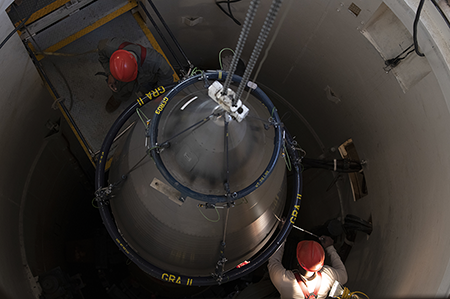
Despite such trends, there is some hope for restraint. The existing nuclear weapons program is already a serious drain on the defense budget. Marquee triad replacement initiatives—the Sentinel ICBM, the Columbia-class ballistic missile submarine, and the B-21 strategic bomber—are all significantly behind schedule and overbudget. As a self-styled canny businessman, Trump could be well served by canceling or reducing programs that clearly are failing.
The Sentinel missile offers the clearest opportunity, having had its budget balloon by more than 80 percent. The missile promises to get more expensive as the Air Force and prime contractor Northrup Grumman face unexpected technical hurdles and the dubious prospect of having to reopen the contract to bidding for new parts.10 Moreover, as the national security focus turns more toward China, U.S. land-based ICBMs can only be targeted effectively against Russia. That is because these ballistic missiles would have to overfly Russia to reach China, likely buying any U.S. president two nuclear wars for the price of one.
Barring significant course corrections, the world should expect Trump to lead an expanding U.S. commitment to the global nuclear arms race. During his first term, Trump broke with nearly 50 years of history by becoming the first U.S. president since Richard Nixon not to negotiate an arms control treaty. That seems unlikely to change given Project 2025’s calls for the administration to outright reject any new treaty that might limit the deployment of U.S. nuclear forces. Paired with growing calls from political forces for the United States to seek technical and numerical superiority in its nuclear arsenal, the prospect of an unconstrained nuclear arms race could pose a real threat.
Facing such a future, experts and advocates concerned with reducing nuclear dangers should remind U.S. leaders that merely possessing more nuclear weapons during the Cold War did little to make the nation safer. Quite the contrary, the unintended accidents, miscalculations, and miscomprehensions caused by seeking nuclear supremacy nearly led to global Armageddon on more than one occasion.
The truth is that the world almost did not survive the last nuclear arms race. U.S. political leaders and military experts should not risk repeating those mistakes by insisting that the only way to ensure national security is to possess more nuclear weapons or introduce more novel and destabilizing nuclear weapons in the hopes of achieving some ultimately unquantifiable supremacy over nuclear rivals.
ENDNOTES
1. U.S. National Park Service, “Manhattan Project: Frequently Asked Questions,” July 19, 2024, https://www.nps.gov/mapr/faqs.htm#:~:text=The%20Manhattan%20Project%20cost%20approximately,War%20Powers%20Act%20of%201941; Daryl Kimball, “Looking Back: The Nuclear Arms Control Legacy of Ronald Reagan,” Arms Control Today, July 2004, https://www.armscontrol.org/act/2004-07/arms-control-today/looking-back-nuclear-arms-control-legacy-ronald-reagan. These figures have been updated to 2023 constant dollars.
2. Geoff Wilson, “America’s Nuclear Weapons Quagmire,” Stimson Center, August 7, 2024, https://www.stimson.org/2024/americas-nuclear-weapons-quagmire/.
3. Mattew J. Belvedere, “Trump Asks Why U.S. Can’t Use Nukes: MSNBC,” CNBC, August 3, 2016, https://www.cnbc.com/2016/08/03/trump-asks-why-us-cant-use-nukes-msnbcs-joe-scarborough-reports.html; Peter Baker and Choe Sang-Hun, “Trump Threatens ‘Fire and Fury’ Against North Korea If It Endangers U.S.,” The New York Times, August 8, 2017.
4. Congressional Commission on the Strategic Posture of the United States, “America’s Strategic Posture,” October 2023, https://armedservices.house.gov/sites/republicans.armedservices.house.gov/files/Strategic-Posture
-Committee-Report-Final.pdf.
5. Office of Senator Deb Fischer, “Fischer: Biden’s Defense Budget Proposal Fails to Address Rising Threats From China and Russia,” April 9, 2024, https://www.fischer.senate.gov/public/index.cfm/2024/4/fischer-biden-s-defense-budget-proposal-fails-to-address-rising-threats-from-china-and-russia.
6. U.S. Senate Committee on Armed Services, “Open/Closed: To Receive Testimony on the Findings of the Congressional Commission on the Strategic Posture of the United States,” October 19, 2023, 54:20-57:00, https://www.armed-services.senate.gov/hearings/to-receive-testimony-on-the-findings-of-the-congressional-commission-on-the-strategic-posture-of-the-united-states.
7. Christopher Miller, “Department of Defense,” in Mandate for Leadership: The Conservative Promise, ed. Paul Dans and Steven Groves, 2023, pp. 95-125.
8. Robert O’Brien, “The Return of Peace Through Strength,” Foreign Affairs, July/August 2024, https://www.foreignaffairs.com/united-states/return-peace-strength-trump-obrien.
9. Office of Senator Roger Wicker, “Senator Wicker Joins National Security Shows to Discuss ‘Peace Through Strength’ Plan,” August 27, 2024, https://www.wicker.senate.gov/2024/8/senator-wicker-joins-national-security-shows-to-discuss-peace-through-strength-plan.
10. Doug Cameron, “U.S. Nuclear Missile Silos Need Modernizing, but Fixes Aren’t Coming Soon,” The Wall Street Journal, August 26, 2024.
Geoff Wilson is a distinguished fellow and senior adviser at the Stimson Center.
December 2024
By Jenny Town
There is great anxiety among U.S. allies and partners about how U.S. President-elect Donald Trump’s second administration will approach alliance management. The potential return to transactional relations raises questions about what new price will be placed on continued partnership and whether countries should pay it. South Korea, in particular, felt the brunt of this treatment during Trump’s first term and is bracing for whatever new demands may come next.
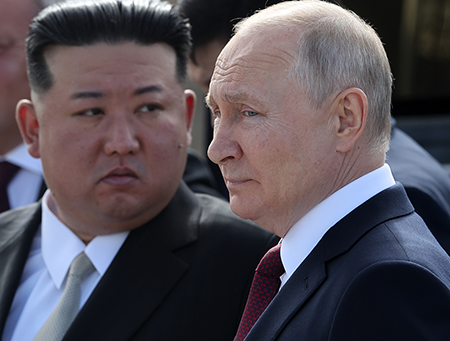
Trump already has taken note of the fact that the South Korean-U.S. Special Measures Agreement, which determines the cost sharing of maintaining U.S. troops on the Korean peninsula, was renegotiated early, presumably to avoid the kind of inflationary pressures that were likely under Trump. The new agreement, concluded in October, raises South Korea’s cost commitment by 8.3 percent to $1.47 billion for 2026.1 The announcement drew criticism from then-candidate Trump, who claimed, “If I were there [in the White House] now, they would be paying us $10 billion a year,” and asserted that the South Koreans “would be happy to do it. It’s a money machine, South Korea.”2
This reaction has concerned many South Korean officials who worry that Trump will push to renegotiate the agreement after he takes office. Whether he will have advisers around him who are willing to curb this impulse is unclear. If not, how South Korean President Yoon Suk Yeol responds to such pressures will set the tone for relations going forward.
If South Korea is forced to renegotiate the agreement, it likely will comply and raise contributions further to some degree, but demand a trade-off in return. The most likely trade-off would be a South Korean demand to renegotiate the South Korean-U.S. nuclear cooperation agreement to grant Seoul enrichment and reprocessing rights.
South Korea has sought this approval for decades for its nuclear energy industry to improve its self-sufficiency and competitiveness and to help manage the industry’s growing spent fuel storage challenge. Although this ambition is largely for peaceful nuclear energy purposes, the intensifying debate in Seoul over whether the country should develop its own nuclear weapons raises serious questions about its intentions toward enrichment and reprocessing activities and undermines its otherwise notable commitment to nonproliferation.
On the North Korea front, Trump is likely to defer direct action in the near term. Ending the war in Ukraine appears to be more of a top priority for him, along with setting the tone for Chinese-U.S. relations. Yet, both of these efforts could have an indirect impact on North Korea, especially its increasingly close relationship with Russia. For instance, conditions about Russia’s relations with North Korea may well be included in any negotiation on Ukraine, thus testing how deeply Russian President Vladimir Putin is invested in keeping North Korea close.
Arguably, Putin would find it more difficult to abandon Pyongyang now that North Korean lives are being sacrificed on Moscow’s behalf. Should an agreement on Ukraine sever, for instance, even just North Korean-Russian military cooperation, this would be well received in South Korea, easing some anxiety over Russia’s potential assistance in improving or advancing Pyongyang’s weapons of mass destruction capabilities. Yet, North Korean leader Kim Jong Un is not likely to take this well after being a loyal partner to Putin throughout his illegal war and signing into law the treaty to codify their partnership, including in the military sphere.
While trying to set a new Chinese-U.S. agenda, Trump may also try to lean on Chinese President Xi Jinping to help moderate North Korea’s behavior, as the U.S. leader did early in his first term. This time, however, such an effort likely would be in vain. Beijing’s influence over Pyongyang has been greatly diminished in recent years as Moscow’s has risen. A change in North Korean-Russian relations could alter that dynamic, but not overnight and probably not to the degree it would take for China to become a credible broker.
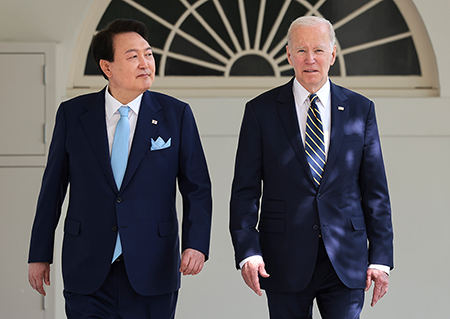
More importantly, Xi has been burned by Trump on this issue. In 2017, Xi agreed to help Trump with North Korea in exchange for not being labeled a currency manipulator and avoiding a trade war with the United States. China did more that year under the maximum pressure campaign than ever before, but despite these efforts, Trump began to gradually impose a series of new tariffs on Chinese imports in 2018 and 2019, triggering retaliatory tariffs from China; and in August 2019, the U.S. Department of the Treasury designated China a currency manipulator.3 Whatever room there may be for Chinese-U.S. cooperation in the current geopolitical environment, North Korea is not the “easy place” to start.
In the meantime, although Trump may think he has time to defer dealing directly with North Korea until he is ready, Kim may not afford him that luxury. Already, North Korea has called for the “limitless” expansion of its nuclear program.4 Earlier this year, it revealed a large uranium-enrichment facility, underscoring its ability to ramp up nuclear weapons production, and flight-tested a new, larger intercontinental ballistic missile.5
So far, presumably for political reasons, North Korea has refrained from additional nuclear weapons testing, despite having at least one untested warhead design. That restraint certainly could be lifted if Kim feels betrayed by his current closest ally to demonstrate his willingness and ability to carry on without outside support. Further progress on reconnaissance satellites, multiple warheads, and reentry vehicle technologies also are expected.
North Korea also could turn more inward to accelerate plans already in motion. Kim has renounced peaceful unification, designated South Korea a hostile state, and severed inter-Korean transportation infrastructure and is working to make permanent North Korea’s sovereignty. Recent references to fortifying the “southern border” suggests further changes are coming that are likely to challenge the legacies of the Korean War, such as the persistence of the Demilitarized Zone itself.6
Questions about whether aspects of the 1950-1953 Korean War Armistice Agreement, such as the continuation of the Demilitarized Zone versus a transition to more normal border management protocols, should be up for piecemeal renegotiation outside of a formal peace treaty process and are likely to come up sooner rather than later. Seoul is unlikely to be willing to negotiate on such matters, but Trump may not dismiss the proposition so easily. Disagreement on how to respond to such a challenge may cause a major rift in South Korean-U.S. relations and renew calls in South Korea for its own nuclear armament.
Under normal circumstances, North Korea’s risk tolerance for taking actions that provoke South Korea and the United States has been consistently higher than what either Seoul or Washington could conceive of doing in return. Even during the “fire and fury” days of the first Trump administration, there was a lot of a fury, but no fire.7 Will that remain true?
Trump seems to believe he has a good relationship with Kim already and that he can take his time.8 North Korea may test him early if only to underscore Kim’s strengthened position this time around. Whether Trump in his second term will be more or less risk tolerant on the Korean peninsula is still an open and worrisome question.
ENDNOTES
1. Young Gyo Kim, “Experts: Future of U.S.-South Korea Defense Cost-Sharing Deal Remains Uncertain,” Voice of America, October 11, 2024, https://www.voanews.com/a/experts-future-of-us-south-korea-defense-cost-sharing-deal-remains-uncertain-/7819599.html.
2. Julian Ryall, “South Korea Shocked by Trump’s ‘Money Machine’ Plan,” Deutsche Welle, October 22, 2024, https://www.dw.com/en/south-korea-shocked-by-trumps-money-machine-plan/a-70564833.
3. Inhan Kim, “Trump Power: Maximum Pressure and China’s Sanctions Enforcement Against North Korea,” The Pacific Review, Vol. 33, No. 1 (2020): 96-124; Danielle Paquette, David J. Lynch, and Emily Rauhala, “As Trump’s Trade War Starts, China Vows Retaliation,” The Washington Post, July 6, 2018; U.S. Department of the Treasury, “Treasury Designates China as a Currency Manipulator,” press release, August 5, 2019, https://home.treasury.gov/news/press-releases/sm751.
4. Kim Tong-Hyung, “North Korean Leader Calls for Expanding His Nuclear Forces in the Face of Alleged U.S. Threats,” Associated Press, November 17, 2024.
5. Olli Heinonen et al., “First Look at North Korea’s Uranium Enrichment Capabilities,” 38 North, September 13, 2024, https://www.38north.org/2024/09/first-look-at-north-koreas-uranium-enrichment-capabilities/; Vann H. Van Diepen, “North Korea Tests New Solid ICBM Probably Intended for MIRVs,” 38 North, November 5, 2024, https://www.38north.org/2024/11/north-korea-tests-new-solid-icbm-probably-intended-for-mirvs/.
6. “North Korea Vows to Block and Fortify Border With South,” Deutsche Welle, October 9, 2024, https://www.dw.com/en/north-korea-vows-to-block-and-fortify-border-with-south/a-70447450.
7. John Walcott, “Trump’s ‘Fire and Fury’ North Korea Remark Surprised Aides: Officials,” Reuters, August 9, 2017.
8. Simone McCarthy, “Trump Claims Kim Jong Un ‘Misses’ Him. But He Faces a Very Different North Korean Leader This Time Around,” CNN, November 8, 2024, https://www.cnn.com/2024/11/08/asia/trump-kim-jong-un-north-korea-intl-hnk/index.html.
Jenny Town is a senior fellow at the Stimson Center and the director of the center's Korea Program and 38 North publication.
December 2024
By Ellie Geranmayeh
When U.S. President-elect Donald Trump reenters the White House, he faces the most advanced Iranian nuclear program to date.1 Iran now has enough fissile material to produce three bombs within weeks. This proliferation threat exists within a Middle East that is on high alert, with Israel and Iran on the brink of wider conflict. These realities could drag U.S. forces into further military operations, just as the incoming president pledged to end the wars in this region.
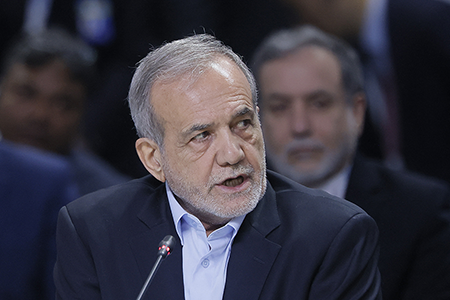
In his first term, Trump backed his hawkish advisers to pursue a “maximum pressure” policy aimed at throttling Iran’s economy. Trump was wrongly sold on the idea that this approach would bring Iran to its knees and result in a capitulation to U.S. demands at the negotiating table. Instead, Tehran expanded its nuclear program and ratcheted up attacks against U.S. forces.
Rather than making a deal with the United States, as Trump hoped, Iran is now increasingly aligned with and economically dependent on China and Russia. Despite U.S. efforts to isolate Iran in the region, the Arab monarchies in the Middle East have pursued rapprochement with Tehran. In short, maximum pressure badly backfired.
The Ball in Trump’s Court
Following the Gaza war and the sharp uptick in military confrontation between Israel and Iran since April 2023, Iran seems to have edged toward a new ultimatum for the incoming Trump administration. Either Trump is dragged into the simmering war between Israel and Iran, or he cuts a deal with Iran that creates a cold peace.
Since the U.S. election, Iranian officials have signaled openness to a direct political track with the Trump administration, warning that a return to a maximum-pressure 2.0 approach “will only result in ‘maximum defeat 2.0.’”2 Iranian Supreme Leader Ayatollah Ali Khamenei seems to have given the green light for the new government of President Masoud Pezeshkian to test new direct negotiations with Washington over the nuclear program. Although it is possible that Khamenei may eventually retrench or undermine this track, for now the ball is in Trump’s court.
During recent campaigning, Trump repeated his desire to cut a deal with Iran. The major unknown is what path he might choose to get to the negotiating table. Trump could choose to repeat the mistakes of his first term by allowing his hawkish foreign policy advisers to double down on maximum pressure policies.
A second, untested option: Trump can use the first 100 days of his administration to open a direct diplomatic channel to Tehran and begin a dealmaking process in ways that President Joe Biden was unable to do. The reported meeting following the U.S. elections between Elon Musk, a member of Trump’s inner circle, and Iran’s envoy to the United Nations could pave the way to advancing this track once Trump takes office.3 Such an opening by itself could help cool the conflict between Israel and Iran immediately and freeze the Iranian nuclear program.
Getting to a Political Process
To get to a political process once Trump is in office, Iran and Trump’s transition team should carefully consider and plan to quickly agree on three key points. First, the two sides need to decide on the format for talks. Iran and the United States usually have used intermediaries, such as European and Arab countries, or multilateral settings such as the P5+1 to negotiate.4 Given tensions between European countries and Russia over the war in Ukraine, that format can no longer be used for near-term talks regarding Iran. The possibility for direct Iranian-U.S. talks should not be ruled out, and Tehran increasingly is signaling that it sees the value in such a format.5
In his first term, Trump’s preference was also for a direct, high-level meeting with Iranian counterparts.6 Back then, this option was unacceptable to Iran, given Trump’s decision to withdraw from the 2015 nuclear accord. It will be even more difficult now for Tehran to accept a meeting with Trump at the onset of talks given his decision to order the assassination of Iranian General Qassem Soleimani in 2020.
Yet, given the latest messaging from Tehran and the meeting with Musk, Iran could be persuaded to advance negotiations with a high-ranking U.S. official and then to finalize the talks at the presidential level. A leader such as Saudi Arabian Crown Prince Mohammed bin Salman, who is close to Trump and is pursuing an important détente with Tehran, could push the two sides to undertake such talks.
Second, Iran and the United States need to decide the agenda and priorities for negotiations. The two sides are at odds over many topics, from nuclear proliferation, their respective military postures in the Middle East, human rights, and Iranian military support to Russia. A major question is whether Trump would seek to isolate Iran’s nuclear program as the highest threat to U.S. national security or take a grand bargain approach.
Neither approach is easy, nor will it lead to satisfactory results. Given the gravity of current tensions and past experience, however, Iran and the United States are unlikely to be able to negotiate a grand bargain. The two sides can unlock better progress by endorsing two parallel yet distinct tracks. The first track should focus on Iran’s nuclear program and entail trade-offs between Iran and the United States. The second track, which should be simultaneous, must intensify the ongoing regional deescalation negotiations with Iran led by Saudi Arabia. Both tracks should seek to bring Iran and Israel back from the brink of war, while acknowledging that the two countries will continue their shadow conflict in the near term.
Finally, at the onset of nuclear talks, Iran and the United States should agree on the immediate and medium-term endgame for negotiations. If, as some administration officials demanded in Trump’s first term, the objective is to get Iran to accept zero nuclear enrichment, the diplomatic process will deadlock quickly.7
A Chance for a New Path
Given robust advances to Iran’s nuclear program, Trump’s immediate goal should be to freeze the program and prevent weaponization activities. It is urgent that Tehran agree to increased international monitoring and supervision over its nuclear activities. This should be coupled with an understanding that Iran and the United States will not target one another militarily and that the simultaneous regional track must progress positively.
In the medium term, Washington should seek to roll back Iranian nuclear capabilities and activities. Although the 2015 nuclear accord can provide a framework, the final agreement will be a new Trump deal with Tehran. This likely requires at least one year of negotiation and possibly four to six months of implementation.
Iran’s new government has prioritized economic recovery and will require a measure of economic relief for each nuclear step. In the near term, a political thaw with the United States would ease the economic situation inside Iran by stabilizing the currency, but Iran will not take costly steps to wind down its nuclear program if the U.S. offer for economic relief is empty. Trump seems to have acknowledged the need to provide Iran with sanctions relief.8
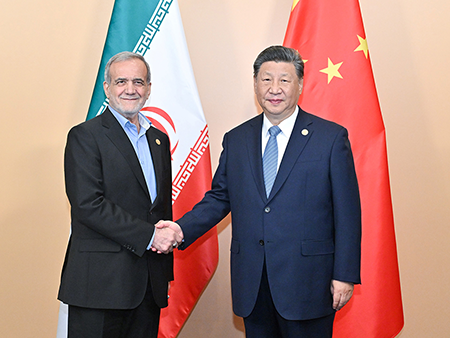
Trump can ease sanctions on Iran through executive orders and nonenforcement. In the immediate term, given the president-elect’s economic tensions with China, one attractive proposition could be to permit the sale of Iranian oil to markets other than China, with the revenues set aside for a specific use and overseen by the U.S. Department of the Treasury.
Even under U.S. sanctions, Iran exports more than 1.5 million barrels of oil per day, almost all to China.9 Iran is believed to be doing this through sanctions-busting routes operated by Iran’s Islamic Revolutionary Guard Corps and often at a steep discount to China, without ease of access to hard currency from such sales. If Iran could export oil without falling foul of U.S. sanctions, it could find potential buyers elsewhere at higher prices. Easier access to oil revenues also will be an attractive proposition for the Iranian government.
In the medium term, as part of a new nuclear deal with Iran, the United States could look to bring on board Arab partners, such as Saudi Arabia, the United Arab Emirates, and Iraq to provide economic relief to Iran. This would be a way to weave together the nuclear and regional tracks of negotiations with Tehran.
Trump instinctively wants a deal with Tehran. He has stated that he is not interested in regime change in Iran, but he wants a deal to ensure Iran does not possess nuclear weapons and is prepared to lift sanctions.10 Yet, it is evident that many will try to block any deal. Chief among them are Trump’s foreign policy advisers, some donors, and the Israeli government. All are pushing Trump to revert back to maximum pressure, arguing that this will “bankrupt” Iran and deprive it of resources to pursue its nuclear and regional goals.11
Continuing down such a confrontational path will bring Trump closer to his nightmare scenario: an Iranian nuclear bomb, an Israeli-Iranian war, and an entrenched U.S. military presence in the Middle East. If instead, Trump follows his gut instincts on dealmaking, quells Israeli opposition, and gets buy-in from the Republican majority in Congress, he can chart a new direction on policy toward Iran in ways that no other U.S. president has managed.
ENDNOTES
1. Stephanie Liechtenstein, “Iran Defies International Pressure, Increasing Its Stockpile of Near Weapons-Grade Uranium, UN Says,” Associated Press, November 19, 2024.
2. Najmeh Bozorgmehr and Bita Ghaffari, “Iran Keeps the Door Open to Talks With Donald Trump,” Financial Times, November 18, 2024; Seyed Abbas Araghchi (@araghchi), X, November 12, 2024, https://x.com/araghchi
/status/1856413334699983297.
3. Farnaz Fassihi, “Elon Musk Met With Iran’s U.N. Ambassador, Iranian Officials Say,” The New York Times, November 14, 2024.
4. The P5+1 comprises China, France, Russia, the United Kingdom, and Germany. They jointly negotiated the 2015 nuclear deal with Iran.
5. “Iran’s President Says Tehran Has to Deal With Washington,” Reuters, November 12, 2024.
6. Robin Wright, “Trump’s Close-Call Diplomacy With Iran’s President,” The New Yorker, September 30, 2019, https://www.newyorker.com/news/news-desk/donald-trumps-close-call-diplomacy-with-irans-president-hassan-rouhani.
7. “After the Deal: A New Strategy,” Heritage Foundation, May 21, 2018, https://www.heritage.org/defense/event/after-the-deal-new-iran-strategy.
8. “Trump on Sanctions,” C-SPAN, November 18, 2024, https://www.c-span.org/video/?c5142328.
9. Clayton Thomas, Liana W. Rosen, and Jennifer K. Elsea, “Iran’s Petroleum Exports to China and U.S. Sanctions,” Congressional Research Service Insight, IN12267, November 8, 2024, https://crsreports.congress.gov/product/pdf/IN/IN12267#:~:text=Iran’s%20petroleum%20exports%20reportedly%20reached,furtherance%20of%20U.S.%20foreign%20policy.
10. PDB Podcast, “Donald Trump Gets Emotional - Speaks on Tariffs, Obama and Iran,” YouTube, October 17, 2024, https://www.youtube.com/clip/UgkxkgQXjYimUvMRxutLHPy8J116KZKYDsWo; Kierra Frazier, “Trump Makes Surprising Overture to Iran at NYC Press Conference,” Politico, September 26, 2024, https://www.politico.com/news/2024/09/26/trump-iran-nyc-press-conference-00181367; “Trump on Sanctions.”
11. Felicia Schwartz and Andrew England, “Trump Team Aims to Bankrupt Iran With New ‘Maximum Pressure’ Campaign,” Financial Times, November 16, 2024.
Ellie Geranmayeh, the deputy head of the Middle East and North Africa program at the European Council on Foreign Relations, focuses on European and U.S. policies related to Iran’s nuclear program and regional activities.
December 2024
By Thomas Countryman
Donald Trump steps again into the U.S. presidency at a time when the risk of nuclear conflict remains unacceptably high, at a level not seen since the 1962 Cuban missile crisis. Amid rising geopolitical tensions, nuclear-weapon states are spending tens of billions of dollars to upgrade their arsenals; and the last remaining agreement limiting the Russian and U.S. arsenals, the world’s largest, will expire in 2026. What is the likelihood that he could reduce that risk, avoid a buildup of strategic nuclear arsenals, and reach new agreements with Moscow to maintain restraint on the Russian and U.S. strategic nuclear arsenals?
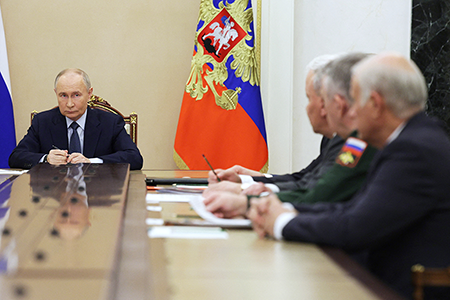
The obstacles are many, even if Trump were to place this task higher among the many dramatic changes he proposes in domestic and foreign policy. First, nuclear negotiations are linked inevitably to the Russian war in Ukraine. Russian President Vladimir Putin’s refusal to engage in any form of discussion with the United States as long as it supports Ukraine against Russian aggression remains the official Kremlin position. Even if Trump is able to force a ceasefire on the combatants, the road to a lasting solution will be long, and Putin is likely to perceive that a refusal to engage in nuclear dialogue could serve as leverage in the negotiations on Ukraine.
Second, any outcome in Ukraine that causes NATO allies to question the reliability of U.S. commitments will cause Europeans to continue to build their own defense capabilities against the possibility of renewed Russian imperialist expansion. There will be an incentive for the allies, in Asia as well as Europe, to pursue the development of their own nuclear “umbrellas,” which serves the interest of neither Moscow nor Washington.
Within the United States, the political impulse of many Republican national security leaders remains to expand rather than constrain the U.S. nuclear arsenal. Actors who are likely to have influence in the new administration already are pushing for new weapons types, a much larger nuclear weapons budget, and perhaps even the resumption of nuclear explosive testing. This trajectory is motivated more immediately by the rapid expansion of the Chinese arsenal than by Russia’s threatening behavior, but will have an effect on the nuclear balance with Moscow. It is also questionable whether U.S. negotiators, who most likely will be chosen on the basis of personal loyalty to Trump rather than on competence, will have the experience and skill necessary to reach new agreements, particularly with the New Strategic Arms Reduction Treaty (New START) expiring in fewer than 430 days.
Despite these headwinds, there remains room for very restrained optimism. Trump’s self-image as the best negotiator ever has driven his interest, going back 40 years, in negotiating nuclear issues with Moscow. His reported desire to be awarded the Nobel Peace Prize could be the incentive to prioritize reaching a breakthrough agreement with Russia, if not with Iran or North Korea. His open admiration and imitation of Putin’s strength form a basis for personal contact that has not existed under the current administration.
There are specific opportunities, short of a sweeping new treaty, that are within reach of the two presidents. Moscow and Washington need to prepare for February 5, 2026, when New START will expire and the binding limitations on deployed strategic arsenals will become history. Both states will have the capability to expand the number of their strategic deployed warheads beyond the treaty limit of 1,550, and this could happen fairly rapidly by uploading reserve warheads onto existing delivery systems.
Yet, there is no serious analysis suggesting that either side would thus enhance deterrence of the other or improve its own national security. In addition, such uploads, not to mention an unrestrained arms race reminiscent of the 1960s, would add greatly to budget and economic pressures in both countries.
Bilateral arms control has never been solely about formal treaties. Russia and its predecessor the Soviet Union and the United States significantly reduced their arsenals by less formal agreements and by reciprocal unilateral steps, particularly the presidential initiatives of the early 1990s. Putin and Trump could reach a political agreement, in brief and clear language, that each would continue to respect New START deployment limits as long as the other side did the same. Trump could even begin the process and gain the praise that would come with it by making this a unilateral statement and inviting Putin to join him.
The two biggest nuclear powers also need to find a way to discuss all elements that bind them together in nuclear danger. It is more than unfortunate that the bilateral strategic stability dialogue ended after the full-scale Russian invasion of Ukraine in February 2022, first suspended by the U.S. side then jettisoned entirely by Moscow. Even U.S. President Joe Biden’s offer of less formal “discussions” on a new nuclear arms control framework have been taken by Russia as a sign of U.S. eagerness and therefore something to be leveraged.
It should be possible to restart contacts among nuclear experts and decision-makers on both sides. To make clear that this is a fresh start, there should be no return to the grand title of strategic stability dialogue. In addition, Moscow would have to climb down from its insistence that the agenda is to formulate a new “strategic equation” that covers every conceivable security issue. That would leave a lot of room for the two sides to begin a discussion that does not exclude any topic of importance to either one. It is less important to have high-level, high-visibility events than to begin and sustain regular discussions at middle levels.
Such a discussion could uncover other areas of potential agreement. One that was too readily dismissed in the past is the possibility of addressing the risk of escalation following the collapse of the Intermediate-Range Nuclear Forces Treaty. Something short of a treaty could reduce the risk and expense of a new missile race in Europe and Asia. The two sides also need to address urgently the new challenge posed by the reported Russian deployment of weapons in outer space and find a way to avoid a new arms race in this dimension.
The world witnessed a dramatic reduction in the risk of nuclear war between 1962 and 2014 as a series of leaders in Moscow and Washington took bold steps to protect the security of their people. U.S. leadership and initiative and the courage to put creative proposals on the table were key to this success at every stage. This moment demands no less. Trump’s foreign policy legacy will depend in great measure on his readiness not just to put forward meaningful ideas, but to see them through to completed agreements.
Thomas Countryman, a retired U.S. diplomat, is chairman of the board of the Arms Control Association.
Ukraine fired U.S.-supplied missiles deeper into Russia after the United States authorized such attacks.
December 2024
By Xiaodon Liang
Ukraine conducted a missile strike Nov. 19 on an armament depot in the Bryansk region of Russia using what Ukrainian and U.S. media described as U.S.-supplied short-range ballistic missiles. The strike took place days after the United States authorized such attacks following months of pressure from Ukraine.
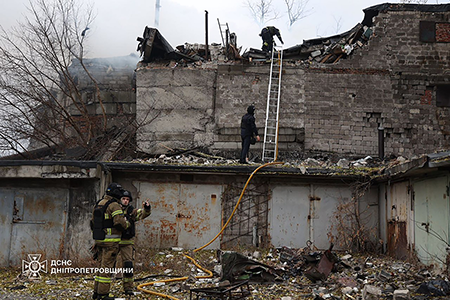
Russia responded two days later by launching a previously unknown intermediate-range ballistic missile at the Ukrainian city of Dnipro as part of a large-scale missile attack. The new missile, called the Oreshnik in televised comments by Russian President Vladimir Putin on Nov. 21, was targeted at facilities that historically have been involved in Ukrainian missile production.
Reuters, The New York Times, The Washington Post, and other media outlets reported on Nov. 17 that they were briefed by unnamed U.S. officials that the Biden administration had lifted its policy barring Ukraine from using U.S.-origin missiles to strike targets far behind the frontlines of the Russian invasion. (See ACT, October 2024.)
Ukrainian President Volodymyr Zelenskyy referred to but did not confirm the decision in a Nov. 17 address. “[S]trikes are not carried out with words. Such things are not announced. Missiles will speak for themselves,” he said.
The United States has provided Ukraine with the Army Tactical Missile System (ATACMS), a short-range ballistic missile with a range of roughly 300 kilometers. These missiles were first used in attacks against Russian forces within occupied Ukraine last year. (See ACT, November 2023.)
But the first use of these weapons against targets in Russia came in the morning of Nov. 19, when the Ukrainian military confirmed it had attacked an armaments depot in the city of Karachev in Bryansk. RBC Ukraine and The New York Times, citing unnamed Ukrainian and U.S. military sources, reported that the strike was conducted using ATACMS.
The same depot was the target of a Ukrainian drone strike in early October. U.S. officials have said that permitting attacks with U.S.-origin weapons systems would not affect the military balance of the war because Ukrainian drones were already capable of reaching Russian targets far behind the frontlines. (See ACT, October 2024.)
The Russian Ministry of Defence said Nov. 26 that Ukraine had conducted additional ATACMS strikes against an airfield and air defense site in the Russian territory of Kursk, Reuters reported.
Ukraine also fired UK-supplied Storm Shadow cruise missiles at targets in Russia for the first time, the BBC reported on Nov. 20. Because these missiles contain U.S.-origin components, they also were subject to the restrictions of the now-lifted U.S. policy.
Official confirmation of the U.S. policy shift came a week after initial reports, when John Kirby, White House national security communications adviser, said in a Nov. 25 press briefing that “we did change the guidance and gave them guidance that they could use them.”
According to media reports, the shift in the Biden administration’s policy was prompted by the arrival of North Korean troops in support of the Russian invasion. The United States believes that about 11,000 North Korean troops are serving in Kursk, where Ukrainian forces have pushed across the international border, according to Nov. 18 comments by a U.S. Defense Department spokesperson.
The decision to permit strikes with U.S.-origin weapons “is reckless, dangerous, aimed at a qualitative change, a qualitative increase in the level of involvement of the United States in this conflict,” Russian presidential spokesperson Dmitry Peskov said Nov. 18, according to Reuters.
Following the strike involving the new Russian intermediate-range missile, Peskov told journalists that “[t]he main message is that the reckless decisions and actions of Western countries that produce missiles, supply them to Ukraine, and subsequently participate in strikes on Russian territory cannot remain without a reaction from the Russian side,” Reuters reported.
A U.S. Defense Department spokesperson said on Nov. 21 that the Oreshnik is an intermediate-range missile derived from the RS-26 intercontinental ballistic missile (ICBM), although Russia has described the new weapon as a “medium-range” missile. The Oreshnik had six warheads, according to a Ukrainian military intelligence press release on Nov. 22.
The RS-26 is classified as an ICBM because it was tested to a range of more than 5,500 kilometers. But during development, Russia also tested the missile at intermediate ranges, raising questions about whether it challenged the spirit of the now-defunct Intermediate-Range Nuclear Forces Treaty. Because these tests did not create a violation of the letter of the treaty, the RS-26 was not central to U.S. allegations of Russian noncompliance. (See ACT, April 2014.)
December 2024
By Tong Zhao
Following President Donald Trump’s reelection, China anticipates a more confrontational U.S. policy and is bracing for intensified strategic competition. Beijing is likely to double down on bolstering its nuclear arsenal, emphasizing the Chinese military Rocket Force mission of “strategic counterbalance,” the use of strategic military capabilities to moderate adversaries’ broader approaches toward China.
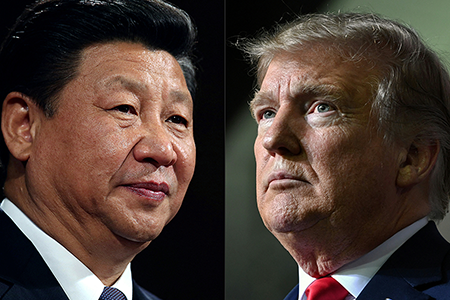
During Trump’s first term, the Chinese leadership came to view the United States as an existential threat, not primarily due to changes in U.S. nuclear policy but because of a severe deterioration in bilateral relations broadly. This has driven Beijing to rely increasingly on the perceived coercive power of nuclear weapons to stabilize its overall relationship with Washington. In Trump’s second term, non-nuclear tensions may escalate further through systematic economic decoupling and heightened geopolitical confrontation.
In the nuclear domain, U.S. patience with China is wearing thin. Beijing’s unwillingness to explain or constrain its nuclear buildup has prompted Washington to consider significant enhancements to U.S. nuclear capabilities. Owing to its deep-rooted siege mentality, China likely will interpret these measures as further evidence of U.S. “hegemonic” ambitions rather than responses to its own actions. Beijing may become more convinced that Washington is actively pursuing a disarming first-strike capability.
The second Trump presidency likely will revive strict visa and security measures, thus constraining personnel exchanges between the two countries. The resulting decline in dialogue between nuclear policy experts could lead both sides to embrace more pessimistic interpretations of each other’s nuclear capabilities, goals, and strategic designs.
Compounding the challenges, Washington’s internal policy environment under the new administration is likely to be highly polarized. Fierce clashes between “pro-deterrence” and “pro-arms control” advocates could lead to intense criticism of many of the administration’s nuclear policy decisions. This internal discord could lead Beijing to view the U.S. political landscape as too unstable for meaningful long-term engagement and thus further entrench its resistance to engaging in substantive strategic dialogue with Washington. Paradoxically, fierce domestic opposition to Trump’s nuclear policies also might amplify unintentionally China’s internal narrative, which fixates on U.S. policy flaws, making Beijing even less likely to recognize its share of responsibility for rising tensions.
The next four years mark a critical juncture in the nuclear paths of both nations. As the Trump administration sets the direction of U.S. nuclear enhancement, China also enters a critical phase of its own nuclear development. Having restructured the Rocket Force leadership, Chinese President Xi Jinping now emphasizes “strengthening targeted training with new equipment, skills, and combat methods.”1 In the coming years, the Rocket Force likely will prioritize developing operational doctrines that define how to employ its expanded capabilities. This process will determine whether and to what extent the leadership’s focus on “combat capabilities” evolves into a more pronounced war-fighting doctrine for its nuclear forces.
A particularly volatile issue lies in the two countries’ approaches to theater-range nuclear forces. Potential U.S. efforts to increase the number of warheads on intercontinental delivery systems may draw attention, but it is the possibility that the United States might deploy tactical nuclear weapons in the Asia-Pacific region that raises greater alarm in China. The second Trump presidency overlaps with Xi’s reported timeline for developing sufficient military capabilities to overtake Taiwan. As the U.S. and Chinese militaries intensify preparations for a Taiwan contingency, they also are conducting increasingly detailed planning for nuclear deterrence in regional conflicts. Each side seeks the ability to manage nuclear escalation if deterrence fails, attempting to prevent unlimited nuclear exchange while securing advantageous terms for ending the conflict.
Once started, competition in escalation management propels rivals into a destabilizing spiral of increasingly diverse and expanding nuclear arsenals. The scarcity of authoritative information about operational military planning on both sides fuels excessive threat perception. It is also difficult to prevent competition that begins at lower rungs of the escalation ladder from expanding upward to higher levels, further increasing the likelihood of a full-scale arms race.
Failure to appreciate action-reaction dynamics heightens these risks. China has assumed mistakenly that its nuclear expansion, including its massive development of increasingly accurate theater-range nuclear-capable missiles, would not provoke responses from other powers. Many U.S. experts also downplay the likelihood that U.S. efforts to enhance low-yield nuclear weapons and forward-deployment capabilities will intensify China’s threat perception and trigger additional countermeasures.
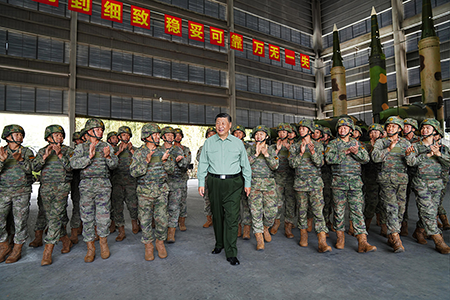
The Trump administration appears prepared to advocate for the expansion of tactical nuclear capabilities, believing that perceived weaknesses in this area could embolden China to consider nuclear first use in a regional conflict. Yet, there is no evidence in Chinese writings or analysis that the Chinese military perceives such weaknesses in U.S. nuclear capabilities. On the contrary, Chinese military analysts are focused predominantly on what they see as a growing U.S. interest in lowering the nuclear threshold and preparing for limited nuclear wars. This perception in turn has driven China’s investments in limited nuclear retaliation and escalation management capabilities.
Likely destabilizing the situation further is the erosion of the global nonproliferation regime. Trump’s anticipated rollback of U.S. security commitments to allies and partners has sparked concerns that countries such as South Korea might pursue nuclear weapons technology. Some U.S. experts are suggesting that Ukraine consider developing its own nuclear weapons option if it cannot secure adequate external security guarantees such as NATO membership. Any shift toward tacitly endorsing such “friendly proliferation” would dismantle decades of nonproliferation norms and remove crucial guardrails in Chinese-U.S. competition. Beijing might interpret this as confirmation that foundational international norms have lost their relevance.
In this climate, convincing China that the Australian-UK-U.S. nuclear submarine program is not a pathway to Australian nuclear weapons development would be much more difficult. It also would be difficult to foresee how Beijing might recalibrate its stance on nuclear nonproliferation in response. Before introducing radical changes with unpredictable consequences, Trump should engage Xi directly on two key issues: initiating serious arms control discussions and addressing how China’s passivity toward Russian aggression and North Korean provocations fuel nuclear proliferation, ultimately undermining China’s own strategic interests.
Confronted with unprecedented risks of nuclear arms races and proliferation, Chinese and U.S. nuclear policy experts carry a historic responsibility to assess critically their respective leaders’ policy choices.
Thoughtful debate on the long-term consequences of their own country’s policies, coupled with a nuanced understanding of their rival’s perspective, is essential to avoiding the catastrophic outcomes of strategic miscalculations.
ENDNOTES
1. “Xi Urges Strategic Missile Troops to Enhance Deterrence, Combat Capabilities,” Xinhua
News Agency, October 19, 2024, https://english.www.gov.cn/news/202410/19/content_WS67136968c6d0868f4e8ec184.html.
Tong Zhao is a senior fellow at the Carnegie Endowment for International Peace, working for the Nuclear Policy Program and Carnegie China.
U.S. President Joe Biden’s decision contradicts his administration's own policy barring such transfers.
December 2024
By Doniyor Mutalov
U.S. President Joe Biden approved plans to supply Ukraine with anti-personnel landmines, changing his administration’s policy barring such transfers and violating the global norm against their use.
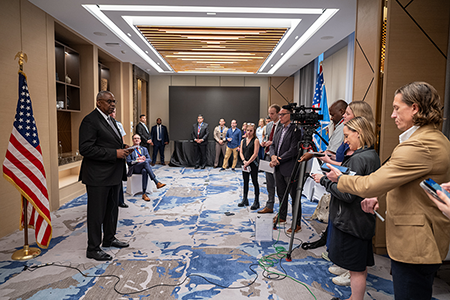
U.S. officials argue that landmines would bolster Ukrainian defenses against Russia’s full-scale invasion. The Ukrainians “have a need for things that can help slow down that effort on the part of the Russians,” Defense Secretary Lloyd Austin told a press briefing on Nov. 20 while traveling in Laos. Austin attempted to address concerns about the humanitarian impact of the landmines by asserting that the United States will provide nonpersistent anti-personnel landmines that are designed to self-destruct.
In a briefing on Nov. 22 at the White House, senior officials said the decision was designed to thwart Russia's increasing reliance on infantry to attack Ukrainian defensive positions.
The decision to supply landmines to Ukraine is a change to U.S. policy adopted in 2022 that prohibits any transfer or export of U.S. landmines and bars their use anywhere except the Korean peninsula. (See ACT, July/August 2022.) The policy also indicated the intention of the United States to “undertake diligent efforts to pursue materiel and operational solutions to assist in becoming compliant with and ultimately acceding to the Ottawa Convention.” The 2022 policy restricted the broader use of landmines permitted by the Trump administration in 2020. At the time, Biden described the Trump administration’s stance on landmines as “reckless.”
The 1997 Ottawa Convention, also known as the Mine Ban Treaty, outlaws the production, use, stockpiling, and transfer of anti-personnel landmines worldwide. As of November, there are 164 states-parties to the treaty, representing more than 80 percent of the world’s states. Ukraine ratified the treaty in 2005, but Russia and the United States are not signatories.
Russia’s relentless use of landmines in the war has already made the conflict zone in Ukraine one of the most heavily mined areas in the world, and the supply of landmines by the United States will very likely exacerbate the contamination.
By acquiring or using anti-personnel landmines, Ukraine will violate its obligations under the Mine Ban Treaty. Ukraine cannot withdraw from the treaty before acquiring landmines because the treaty bars withdrawal if a state-party is engaged in armed conflict. A decision to withdraw would only enter into effect after the end of the Russian war against Ukraine.
The fifth review conference of the Mine Ban Treaty will take place in Cambodia Nov. 25-29 and will be attended by representatives of the United States and Ukraine.
